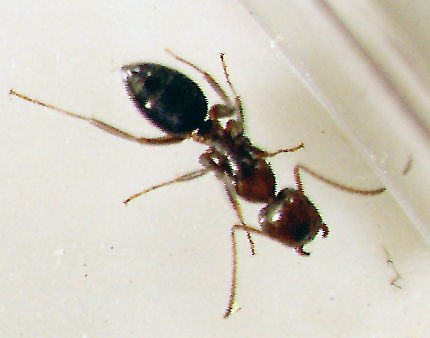Is this a good enough photo to get an ID?
Thanks,


Is this a good enough photo to get an ID?
Thanks,

My Journals:
Normally you should provide some information along with it. Right away it looks like Polyergus to me, but some info would help. Check out the sticky thread on this subforum.
Size would be pretty useful for people to ID her.
The sharp mandibles remind me of the Polyergus I've seen in ant documentaries, however neither of the Polyergus species listed in California on Antweb match this ants coloring.
Here's my leopard gecko/ant youtube: https://goo.gl/cRAFbK
My ant website.
It contains a lot of information about ants, guides, videos, links, and more!
If you have any feedback, please post here or PM me, don't be shy!
I currently keep:
Formica podzolica
Sorry bout that Drew, I should have read that first. I was unable to edit the title, so I'll just go from here:
Location of collection: San Jose, CA. West side of town near Apple Computer Company. In my Kitchen.
Date of collection: 2/13/15
Habitat of collection: Countertop, butcher block style. The outdoor habitat used to be fruit orchards about 50 years ago. Today is a surburban area located between two freeways, and approx 1/4 mile East of the Santa Cruz Mountains. The Santa Cruz mountains are a low elevation coastal range that has mostly coastal redwood trees, and some various varieties of Oak trees.
Length: Approx 6 mm.
Coloration: They look dark brown to me, sometimes they look black to me. When I looked at it under my microscope, it looked to me like a pavement ant.
Anything else: All I have seen appear to be scouts, I haven't seen any ant trails, and I haven't seen any of these outside my home. The individuals I have seen have been spotted all over my home, but primarily in the kitchen. My wife says they get into the honey and sugar, but I have yet to see an ant trail, it appears it's only individuals she's seeing in the food.
I couldn't provide a photo of a profile view because I really don't know how to handle the ants like that. I'm hoping you guys can teach me how to do that.
Thanks for any help you can provide.
My Journals:
Hmm, well maybe it's just the angle, but the mandibles looked just like Polyergus. Can you try to get any other pictures?
Edited by Michaelofvancouver, February 13 2015 - 9:12 PM.
Here's my leopard gecko/ant youtube: https://goo.gl/cRAFbK
My ant website.
It contains a lot of information about ants, guides, videos, links, and more!
If you have any feedback, please post here or PM me, don't be shy!
I currently keep:
Formica podzolica
I'll try bud but I honestly don't know how to go about it. Any ideas or recommendations would be appreciated.
My Journals:
This is about the best I was able to adjust it. Does this look fairly accurate?

Lasius? I remember once I thought something was Polyergus due to mandible shape, and was corrected, turning out to be some sort of Lasius.
Any additional picture would help. Things look different from different angles, and seeing more than one angle really helps.
Lasius? I remember once I thought something was Polyergus due to mandible shape, and was corrected, turning out to be some sort of Lasius.
Wouldn't 6mm be pushing it for Lasius? Unless you're talking about a parasitic queen.
I wish Dr. Trager would come back; we could really use his expertise right now.
6mm is way way too big for Lasius workers. That is for sure unless it's a queen which from the picture alone it's not.
Yeah, we probably need more pictures in different angles.
Maybe a Formica sp.
I'm sorry I'm struggling to get a decent profile picture. These ants are dead/dying and look shorter than the live/healthy one I photographed. These appear maybe 4-5 mm. It looks like they have 1 node.


My Journals:
Camponotus I think. If it is, it would be one from the Myrmentoma subgenus--they can be pretty small. The mandibles just looked really weird in that first picture. This fits your behavior description much better.
Check these out and tell me if they look similar:
http://www.alexander...ord/myrmentoma/
Edited by dspdrew, February 14 2015 - 12:40 PM.
Yeah, it's not Formica because of the single bump on the thorax.
A small species of Camponotus seems about right.
Here's my leopard gecko/ant youtube: https://goo.gl/cRAFbK
My ant website.
It contains a lot of information about ants, guides, videos, links, and more!
If you have any feedback, please post here or PM me, don't be shy!
I currently keep:
Formica podzolica
So it's definitely not Tetramorium sp because that has two nodes, and my specimen only has one node, is that correct?
My Journals:
That would be correct.
It does look like a Camponotus sp.
Edited by Jonathan21700, February 16 2015 - 10:09 AM.
0 members, 1 guests, 0 anonymous users